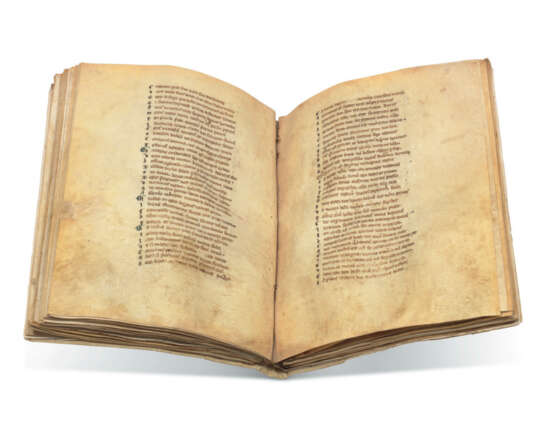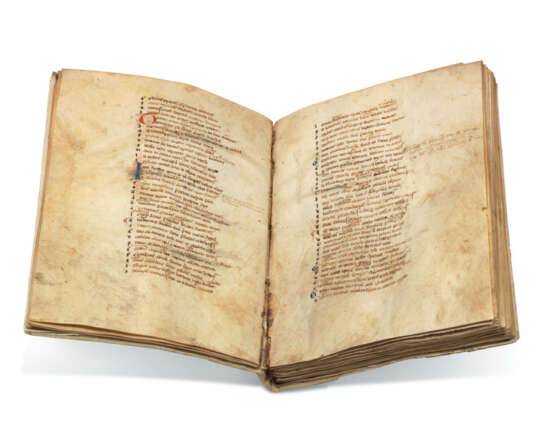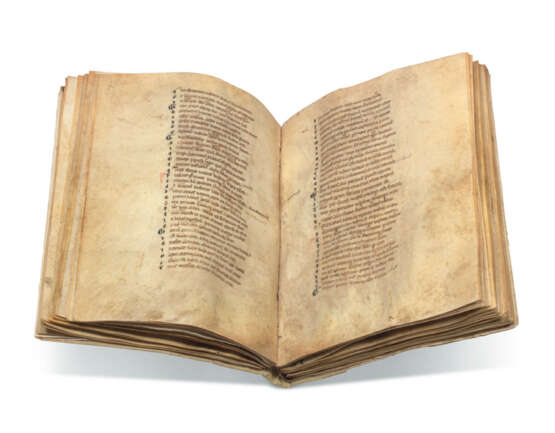ID 993356
Lot 47 | Walter of Châtillon (1135-1180)
Estimate value
£ 30 000 – 50 000
Walter of Châtillon (active 1170-180), Alexandreis, in Latin, decorated manuscript on vellum [Florence, c.1450s].
A vanishingly rare appearance on the market of one of the most popular epic poems of the Middle Ages: Walter of Châtillon’s Alexandreis, written in a fine Florentine script of the 15th century.
203 x 140mm. i + 53 + i leaves, collation: 16, 2-410, 511 (of 10, iii loose and misplaced within text), 66, modern pagination in pen 1-106 followed here, c.32-36 lines of hexameter verse in a 15th-century Florentine script, the initial of each line touched in blue, larger initials in red with purple penwork decoration or blue with red penwork decoration, contemporary annotations throughout (lacking around 30 leaves, including around 10 leaves with the Prologue, Book I and the first half of Book II until line 189, two leaves in Book III with lines 87-218, 10 leaves in Books VIII-IX with VIII.12-IX.174, 4 further leaves in Books IX-X with lX.384-X.65 and the end of Book X, pp.29-32 supplied on paper, warping to vellum, marginal damp-staining throughout, especially to pp.1-7 and 102-103, some tears, flaws and contemporary repairs to vellum). White vellum binding (a little stained and warped).
Content: The text begins in Book II, line 189: ‘Increpat usque metus ac secum pauca susurrat’; Book III, pp.12-20 (p.77-78 is misnumbered and should follow p.14); Book IV pp.20-42; Book V pp.42-58; Book VI pp.58-75; Book VII pp.75-94; Book VIII p.94; Book IX, beginning line 175, pp.95-100; Book X pp.101-106, ending at line 268 ‘Miserat intextum, galeam Kartago pyropo […]’.
Alexandreis (or Alexandreid) is a medieval Latin epic poem by Walter of Châtillon, a 12th-century French writer and theologian who studied under Stephen of Beauvais and wrote a large number of poems in the Goliardic manner that found their way into the Carmina Burana collection. Alexandreis is a skilful versification of Curtius Rufus’ prose biography of Alexander the Great, and an important version of the Alexander romance, giving an account of the life of Alexander the Great. Composed in ten books of hexameter verse during the last quarter of the 12th century, it was popular and influential in Walter's own time, even being translated into Icelandic prose as the Alexanderssaga and being given the ultimate accolade by Henry of Brussels when he stated that, in comparison with it, the reading of the ancient authors was being neglected in schools. Over 200 manuscripts are extant, with an abundance of interesting variants, with several copies in British libraries. It is, however, exceptionally rare on the market, with only a single copy – part of a compilation – having appeared at auction in the last century (Sotheby’s, 5 December 1989, lot 96).
Special notice
No VAT is payable on the hammer price or the buyer's premium for this lot. Please see the VAT Symbols and Explanation section of the Conditions of Sale for further information
| Artist: | Walter of Châtillon (1135 - 1200) |
|---|---|
| Place of origin: | Italy, Europe |
| Auction house category: | Medieval & renaissance manuscripts |
| Artist: | Walter of Châtillon (1135 - 1200) |
|---|---|
| Place of origin: | Italy, Europe |
| Auction house category: | Medieval & renaissance manuscripts |
| Address of auction |
CHRISTIE'S 8 King Street, St. James's SW1Y 6QT London United Kingdom | |
|---|---|---|
| Preview |
| |
| Phone | +44 (0)20 7839 9060 | |
| Buyer Premium | see on Website | |
| Conditions of purchase | Conditions of purchase |






